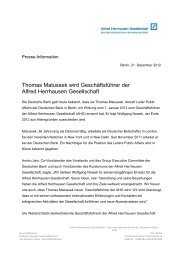Charting new directions: - Alfred Herrhausen Gesellschaft
Charting new directions: - Alfred Herrhausen Gesellschaft
Charting new directions: - Alfred Herrhausen Gesellschaft
Create successful ePaper yourself
Turn your PDF publications into a flip-book with our unique Google optimized e-Paper software.
12<strong>Charting</strong> <strong>new</strong> <strong>directions</strong>: Brazil’s role in a multi-polar worldPathways to sustainable growthThe current financial crisis seems to have dealt aserious blow to the American neoliberal growthmodel, which encouraged conspicuous levels ofconsumption and allowed for high levels of debt. EastAsian growth strategies, based on export-led growth,high savings and low levels of domestic consumptionare also under pressure. And, as the global economybegins to recover, there are still no clear pathways tosustainable growth.In Brazil, the previous President, Luiz Inácio Lula daSilva, continued the market-oriented policies of hispredecessor, Fernando Henrique Cardoso, includingfiscal discipline and a floating exchange rate, in orderto maintain macroeconomic stability. But thesepolicies were combined with a developmentalistapproach to social policy and strategic interventionsin the economy through a raft of industrial policies.This led to the resilience of the Brazilian economyin the face of the financial crisis, but significant risksand dilemmas remain.At the macroeconomic level, there is the dilemmaof how to maintain public spending in a way that isconsistent with fiscal stability. As Nelson Barbosaargues, this may be possible by bringing moreeconomic activity into the formal sector with theresultant benefits for public revenues. There isalso concern about how to encourage growth andinvestment in a manner that does not accelerateinflation. And, therefore, the interest rate, whichis amongst the highest in the world, is a highlycontentious issue in Brazil with many advocating ahigh interest rate to keep inflation levels low whileothers argue for a lowering of the interest rate inorder to make credit for investment more easilyavailable.Many are optimistic that Brazil may be able toovercome these dilemmas by harnessing its naturalresources. The recent discoveries of oil and gas offthe coast of Brazil present the country with a valuableopportunity and it has the potential to utilise theseenergy resources for its economic development,as Mauricio Tolmasquim and Amilcar Guerreiroadvocate. Brazil’s rich commodity base is a hugeadvantage, but there are also risks associated withexcessive reliance on primary products. As Yao Yangpoints out, a resource curse hangs over commodityrich countries, where improved terms of trade forthe export of commodities (in particular currencyappreciation) often reduce the competitiveness ofthese countries in manufactured goods.Indeed, there is debate in Brazil about whether toemphasise commodity production or manufacturingas the path to economic growth. However, such astark choice may not be necessary and there couldbe synergies between the two sectors if the Braziliangovernment is strategic in its choices, such asutilising profits from commodity exports to financethe diversification and development of the rest of theeconomy and create jobs. In addition, as Glauco Arbixargues, innovation will be increasingly significant inhelping spur economic growth across each of thesesectors. However, if the Brazilian economy is toenhance growth and achieve innovation, a numberof complex and difficult structural changes will benecessary, including further tax and financial reformsto facilitate financing and the growth of small- andmedium-sized businesses, and broad infrastructuralimprovements.Internal tensions and social cohesionThe changes associated with globalisation have puta strain on the social fabric of countries, with risingindividualism in metropolitan areas, while exposingdeep divisions between regions, rural and urbanareas, socioeconomic groups and ethnicities. AsWilliam Galston and Niraja Gopal explore in theircontributions, this is as true in advanced industrialisedcountries such as the United States as it is in thedeveloping world, where huge income disparitiescontinue to widen.In this context, Brazil’s recent experience can beconsidered a success story. Through a combinationof orthodox macroeconomic policies and anIntroduction: Reclaiming the future | <strong>Alfred</strong>o Cabral, Elena Jurado and Priya Shankar








